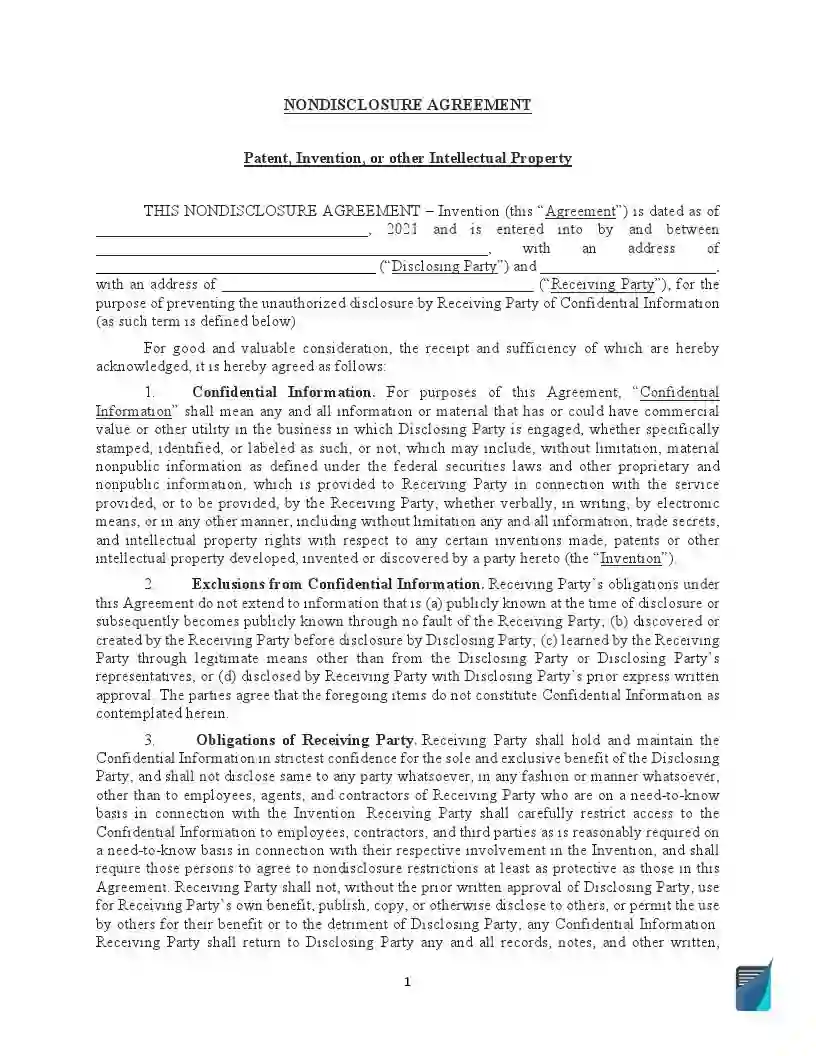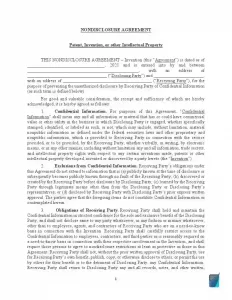Invention (Patent) Non-Disclosure Agreement
A non-disclosure agreement for inventions and patents is not used to prevent disclosure of a patent as the name suggests. Instead, it is used to prevent the disclosure of confidential information in a pending patent or innovations and strategies that may become patents. Nothing that was public information before the patent was signed is protected by this NDA agreement.

Build Your Document
Answer a few simple questions to make your document in minutes
Save and Print
Save progress and finish on any device, download and print anytime
Sign and Use
Your valid, lawyer-approved document is ready
Why Use an NDA for an Invention or Patent?
Just as with any other non-disclosure agreement, an invention NDA protects information that you do not want to be shared with others. Patent applications are public information but what they are used for is not. An invention non-disclosure agreement covers that information and keeps everything protected until it is ready for the public.
An invention, by definition, is something new that improves a process. This can be a product, strategy, or software. If it can be used to improve business operations or even for everyday people, it can be protected by an invention non-disclosure agreement. New ideas and developments are made every day and you want to be sure that they are adequately protected.
An inventor may use an invention confidentiality agreement to work with investors, contractors, and manufacturers to discuss what the patent will do without the risk of information becoming public. Knowing what a patent is intended to do can create problems for the inventor when other people are trying to do the same thing.
A patent’s intended purpose can fall under trade secret regulations and is protected by an invention NDA. An idea can prove to be an important aspect of how a business is run and everyone who understands how the invention works should understand what they are not allowed to talk about.
Having an invention confidentiality agreement will define what is protected information in regards to the patent. An inventor will want to use an invention non-disclosure agreement with all receiving parties to keep their idea and invention safe before the patent is ready to be revealed.
A non-disclosure agreement template will provide a foundation of how to define and categorize the different aspects of what the patent does. The template will provide the layout of what to expect if the contract is breached and what information is protected. It’s easier for most people to work from a template to make sure that everything is covered and that information will be protected.
Without using the nda template, it will be difficult to establish what different parties knew at what time and if the contract was broken. This can create an expensive and time-consuming court process to determine if any secrets were disclosed and what the penalties should be. Having everyone sign an invention non-disclosure agreement will help simplify the process for everyone.

What to Include in Such a Confidentiality Agreement
A non-disclosure agreement template will include the basics of what to have in any non-disclosure agreement. Much of this information will cover what needs to be for an invention non-disclosure agreement and you can add the necessary information as needed.
1. Definition of Confidential Information
The first part to include in an invention NDA is the definition of confidential information. For a patent, this will include the idea of the patent and what it does. By establishing the definition of confidential information it will be easier to enforce.
2. Exceptions
Once the definition is included, the invention non-disclosure agreement will cover exceptions. This will cover what was publicly known at the time of disclosure, discovered by the receiving party before the contract was signed, and information learned through legitimate means.
3. Obligations of Receiving Party
After these definitions have been established, the obligations of the receiving party will be noted. This includes protecting an idea that is not yet ready to be made public and returning any materials without sharing them or making copies without permission. The receiving party may use these materials to make notes on them but cannot share them with others without permission.
4. Date of Contract
A date can also be included in the invention confidentiality agreement to establish if and when the agreement is in effect. This can be a specific date or when certain criteria have been met, either when the receiving party is released from the agreement or the information discussed in the agreement is no longer confidential.
5. Severability
A non-disclosure agreement template will also include information about what will happen in the event the invention NDA is decided to be unenforceable by a court and what state the agreement is made under. Every state has different regulations about non-disclosure agreements.
6. Breach of Contract
One of the key components of an invention non-disclosure agreement is the understanding of what will happen if the agreement is breached. The contract will determine what legal action the inventor can take upon the receiving party. This will typically involve paying for compensation and covering legal fees.
7. Signature and Date
Once the agreement is signed and dated by all parties, it is enforceable unless otherwise stated. Before signing, the receiving party should be clear about the definitions and terms that are being agreed to.
Using a non-disclosure agreement template will make many aspects of writing the confidentiality form much easier. With this agreement, all parties will have a firm understanding of what is covered under the agreement and how the idea protected will be kept secret until the inventor is ready to disclose it.
What is Proprietary Information and Inventions Assignment Agreement?
Proprietary information is confidential information concerning a group’s business affairs and any matter concerning the business and third parties. It does not include public information or information that one learns about through legal means. Proprietary information has a similar definition to trade secrets and can be used interchangeably.
Proprietary information covers strategies, operations, finances, business plans, studies, policies, software systems, and technical know-how. Any information that a business uses to understand and plan its business strategy better is covered under proprietary information and can be protected with a non-disclosure agreement.
With an invention non-disclosure agreement, the inventor will want to establish what proprietary information is included in the agreement. This can range from the idea of the product to what the product or service does. Proprietary information can cover a broad range of ideas and services and your invention confidentiality agreement should cover the definitions you are using.
When working for an employer, you may be asked to sign an inventions assignment agreement. This agreement establishes that any intellectual property of an employee belongs to the employer. Seven states have statutes concerning inventions assignment agreements with similar legal requirements. If drawing one up you should closely follow those statutes to ensure that they are enforceable.
This is a complicated legal matter when it comes to developing new ideas and products for a company. An invention NDA will not protect your ideas if you are working for an employer with inventions assignment agreements.